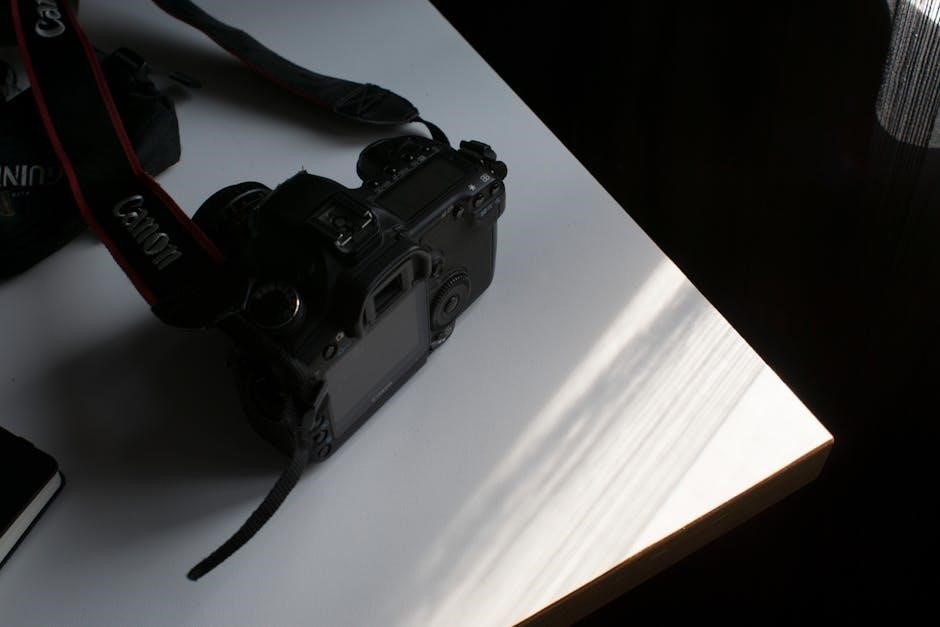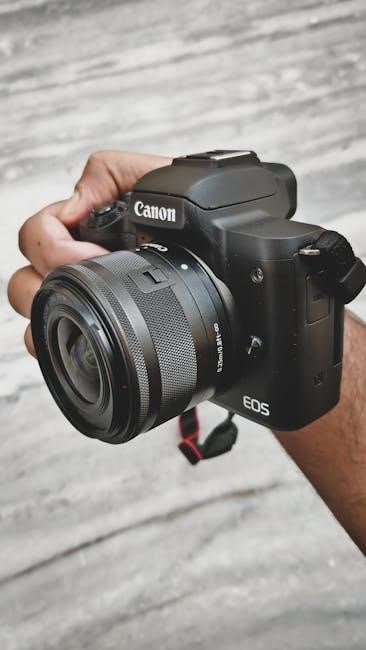The Canon EOS R5C manual is a comprehensive guide designed to help users master both photo and video capabilities of this hybrid camera.
It includes a quick start guide‚ detailed instructions‚ and advanced features to optimize performance for professionals and beginners alike.
1.1 Quick Start Guide
The Quick Start Guide in the Canon EOS R5C manual provides essential steps to get started with the camera. It covers unboxing‚ charging the battery‚ and basic setup.
Users can learn how to insert memory cards‚ navigate the menu system‚ and understand the mode dial. The guide also explains fundamental shooting settings‚ such as selecting photo or video mode and adjusting exposure controls. Designed for quick reference‚ it helps users begin capturing high-quality content immediately. Additional details on advanced features are covered in later sections for deeper exploration.
1.2 Importance of Reading the Manual
Reading the Canon EOS R5C manual is crucial for unlocking its full potential. The manual provides detailed insights into advanced features‚ allowing users to optimize settings for their creative needs. It explains complex functions like Dual Pixel CMOS AF and Cinema RAW Light‚ ensuring users understand how to utilize them effectively. By familiarizing yourself with the manual‚ you can troubleshoot common issues‚ improve efficiency‚ and avoid trial-and-error mistakes. This guide empowers photographers and filmmakers to harness the camera’s capabilities confidently‚ enhancing both productivity and creativity.
1.3 Key Features of the Canon EOS R5C
The Canon EOS R5C stands out as a hybrid powerhouse‚ blending high-end photo and video capabilities. It features a 45MP full-frame CMOS sensor‚ DIGIC X processor‚ and 8K ProRes RAW video recording. The camera boasts dual-pixel CMOS AF for precise focus‚ 5-axis in-body image stabilization‚ and a vari-angle touchscreen LCD. It supports CFexpress and SD card slots for fast data transfer. With HDMI 2.1 output‚ Wi-Fi‚ and Ethernet connectivity‚ the R5C is designed for professional workflows‚ offering unparalleled versatility for photographers and filmmakers alike.

Camera Overview
The Canon EOS R5C is a versatile hybrid camera designed for professional photographers and filmmakers‚ offering a robust build‚ advanced features‚ and seamless integration for creative workflows.
2.1 Physical Design and Layout
The Canon EOS R5C features a magnesium alloy body‚ providing durability and lightweight construction. Its weather-sealed design protects against dust and moisture‚ making it suitable for outdoor use. The ergonomic design includes a contoured grip for comfortable handling‚ with intuitive control placement for easy access to key functions. A vari-angle touchscreen LCD allows for flexible composition‚ while the mode switch enables quick transitions between photo and video modes. The camera’s layout is optimized for both stills and video workflows‚ ensuring efficiency and creativity in professional environments.
2.2 Key Specifications of the EOS R5C
The Canon EOS R5C boasts a 45-megapixel full-frame CMOS sensor‚ powered by the DIGIC X image processor‚ delivering high-resolution stills and video. It offers an ISO range of 100-51‚200‚ expandable to 50-819‚200 for low-light conditions. The camera supports continuous shooting at up to 20 fps with the electronic shutter; Video capabilities include 12-bit RAW internal recording at 8K/30p and 4K/120p‚ along with HDMI output for external recording. These specs make it a versatile tool for both photographers and videographers‚ blending high performance with advanced features.
2.3 Differences from the Canon EOS R5
The Canon EOS R5C differs from the EOS R5 primarily in its enhanced video capabilities. While the R5 excels in photography with a 45-megapixel sensor and 8K video‚ the R5C is optimized for videography‚ offering advanced features like higher frame rates and better codec options. The R5C has a more robust body with additional ports for HDMI and audio inputs‚ improving its suitability for professional video production. Its menu system is tailored for video settings‚ and it may have improved autofocus for smoother focusing during recording. Battery life and storage options might also vary‚ with the R5C potentially supporting faster memory cards and longer battery life to handle high-resolution video demands. The R5C is likely positioned as a higher-end model‚ catering to professionals who require top-tier video capabilities‚ and may be more expensive than the R5. Firmware updates for the R5C are expected to focus more on enhancing video functionalities compared to the R5.

Shooting Modes
The Canon EOS R5C offers versatile shooting modes tailored for both photo and video‚ ensuring flexibility and creativity in various shooting scenarios‚ from stills to cinematic footage.
3.1 Photo Mode Operations
In Photo Mode‚ the Canon EOS R5C offers intuitive controls for capturing high-quality still images. Users can select from various shooting modes‚ including Manual‚ Aperture Priority‚ Shutter Priority‚ and Program Mode. The camera allows adjustment of ISO‚ white balance‚ and autofocus settings to optimize image quality. Burst shooting is supported for dynamic action photography. The R5C also features customizable buttons for quick access to frequently used settings‚ streamlining the workflow for photographers. The electronic shutter enables silent shooting‚ making it ideal for discreet capturing in sensitive environments.
3.2 Video Mode Operations
In Video Mode‚ the Canon EOS R5C excels with advanced features tailored for professional filmmakers. It supports 12-bit RAW video recording and high-resolution 8K footage at 30fps‚ ensuring exceptional detail. The camera offers frame rates up to 120fps for smooth slow-motion capture. Users can enable Canon Log 3 for greater dynamic range and HDR support for enhanced color accuracy. Focusing is seamless with Dual Pixel CMOS AF‚ which tracks subjects precisely during recording. Additional controls like ISO‚ white balance‚ and audio levels can be adjusted for fine-tuned results‚ making the R5C a versatile tool for cinematic storytelling.
3.3 Switching Between Photo and Video Modes
Switching between Photo and Video modes on the Canon EOS R5C is seamless. The camera features a dedicated switch near the mode dial‚ allowing quick transitions. In Photo mode‚ settings like aperture‚ shutter speed‚ and ISO are optimized for still images. In Video mode‚ these settings adjust for motion capture‚ with options for frame rates‚ resolution‚ and recording formats. The mode dial also includes settings for photo and video‚ ensuring intuitive operation. Customizing the switch in the menu enables tailored workflows‚ enhancing efficiency for hybrid shooters. This dual functionality makes the R5C ideal for diverse creative needs.

Menu Functions
The Canon EOS R5C menu system offers intuitive navigation for photo and video settings. Organized into tabs like Movie‚ Photo‚ and Playback‚ it simplifies customization and workflow.
4.1 Navigating the Menu System
The Canon EOS R5C menu system is organized into intuitive tabs‚ including Movie‚ Photo‚ and Playback. Use the multi-controller or touchscreen to navigate. Each tab contains settings specific to its mode‚ reducing clutter. The Quick Menu provides fast access to frequently used settings‚ customizable to your workflow. Pressing the Q button or tapping the screen brings up this menu. The menu adapts to the camera’s mode‚ ensuring relevant options are always front and center. This streamlined design enhances efficiency for both photo and video workflows.
4.2 Custom Settings and Presets
The Canon EOS R5C allows users to save personalized shooting settings as custom modes (C1‚ C2‚ C3) for quick access. These modes can store parameters like exposure‚ autofocus‚ and color settings‚ tailored to specific workflows. Access custom settings via the menu under the Custom Shooting Mode tab. Rename or adjust presets to suit your needs. This feature streamlines operations‚ saving time during shoots. Additionally‚ custom settings can be managed and synced with Canon software for seamless integration into your workflow.
4.3 Accessing Advanced Menu Features
To access advanced menu features on the Canon EOS R5C‚ navigate to the Custom Functions tab in the menu system. Here‚ you can enable or disable advanced settings like RAW video processing‚ custom autofocus configurations‚ and enhanced audio controls. Some features may require enabling Advanced Mode in the camera settings. Use the MENU or Q buttons to quickly access these options. This section allows for fine-tuned adjustments‚ catering to professional needs for both photo and video workflows.

Autofocus and Metering
The Canon EOS R5C offers advanced autofocus and metering systems‚ ensuring precise focus and exposure control. Dual Pixel CMOS AF and multi-zone metering deliver exceptional accuracy for both photos and videos.
5.1 Autofocus Modes and Settings
The Canon EOS R5C features advanced autofocus modes‚ including Face+Tracking‚ Eye AF‚ and Subject Detection. These modes enable precise focus tracking‚ even in dynamic scenes. Users can customize AF settings‚ such as sensitivity and speed‚ to suit their workflow. The camera also supports manual focus override‚ allowing for fine adjustments. With real-time AF‚ the R5C excels in capturing sharp images and videos‚ ensuring subjects remain in focus. These modes are easily accessible via the touchscreen or physical controls‚ making it intuitive to adjust settings on the fly.
5.2 Metering Modes Explained
The Canon EOS R5C offers multiple metering modes to ensure accurate exposure. Evaluative Metering analyzes the entire scene for balanced results. Spot Metering measures light from a specific area‚ ideal for high-contrast subjects. Center-Weighted Metering prioritizes the center of the frame while considering the surrounding areas. Additionally‚ the camera supports Highlight-Weighted Metering‚ which prevents overexposure in bright regions; These modes can be selected based on the shooting scenario‚ allowing users to achieve precise control over exposure and create consistent‚ professional-quality images and videos.
5.3 Customizing Focus and Exposure
The Canon EOS R5C allows for extensive customization of focus and exposure settings to suit individual preferences. Users can adjust autofocus tracking sensitivity‚ subject detection‚ and eye-tracking behavior for precise subject capture. Exposure compensation and auto ISO limits can be tailored for optimal results in various lighting conditions. Customizable buttons enable quick access to frequently used focus and exposure controls‚ streamlining workflows. These personalization options empower users to refine their shooting experience‚ ensuring consistent and professional-grade output in both stills and video.

Image and Video Quality
The Canon EOS R5C delivers exceptional image and video quality‚ capturing intricate details with its high-resolution sensor and advanced processing. It supports 8K video recording‚ ensuring cinematic-grade output with vibrant colors and minimal noise. The camera’s dynamic range and color accuracy enable stunning still images and smooth transitions in video‚ making it ideal for professional photographers and filmmakers seeking precise control over visual output.
6.1 Still Image Capture Settings
The Canon EOS R5C offers extensive still image capture settings‚ allowing photographers to tailor their workflow. Image quality can be set to RAW‚ JPEG‚ or HEIF formats‚ with options for resolution and compression levels. The camera supports high-speed continuous shooting and features advanced noise reduction for clean images in low-light conditions. Custom profiles enable personalized color and sharpness adjustments. The manual provides guidance on optimizing settings for specific genres‚ from landscapes to portraits‚ ensuring maximum detail and dynamic range. File naming conventions and metadata embedding are also customizable for efficient organization.
6.2 Video Recording Formats and Resolutions
The Canon EOS R5C supports a wide range of video recording formats and resolutions‚ catering to both professional and creative needs. It offers 8K RAW at 30p‚ 4K up to 120p‚ and HD at 180p. Formats include XF-AVC‚ MP4‚ and Cinema RAW Light for enhanced flexibility. Users can choose from various color spaces like BT.709 and BT.2020. The camera also allows customization of frame rates‚ resolution‚ and bitrates‚ ensuring optimal quality for different workflows. HDR recording is supported‚ and Proxy files can be generated for efficient editing.
6.3 HDR and RAW Image Options
The Canon EOS R5C offers advanced HDR and RAW image options for enhanced creativity and quality. HDR (High Dynamic Range) captures a wider range of tonal values‚ delivering images with richer contrast and color accuracy. RAW files‚ such as .cr3‚ preserve uncompressed image data for maximum post-processing flexibility. The camera supports HDR PQ and HDR10 formats‚ as well as HEIF for HDR photos. RAW images can be recorded separately or alongside JPEGs‚ allowing users to maintain high-quality originals while having ready-to-use files. These options ensure optimal results for both stills and video workflows.

Memory and Storage
The Canon EOS R5C supports CFexpress and SD memory cards‚ ensuring high-speed data transfer and storage. Dual card slots enable efficient data management and backup options.
7.1 Compatible Memory Cards
The Canon EOS R5C supports CFexpress Type B and SD UHS-II memory cards‚ ensuring high-speed data transfer and storage for demanding tasks like 8K video and continuous shooting. Dual card slots allow for simultaneous recording to both cards‚ providing redundancy and backup options. For optimal performance‚ use CFexpress 2.0 cards for video workflows and high-speed SDXC UHS-II cards for still photography. Always verify compatibility with Canon’s official specifications to ensure reliable operation.
7.2 Managing Storage Space
Efficient storage management is crucial for uninterrupted shooting. Regularly check card capacity and format cards before use to avoid data conflicts. Use the camera’s built-in tools to estimate file sizes and plan storage accordingly. Organize files by date or type using folders. For high-resolution video‚ prioritize CFexpress cards for faster write speeds. Consider using multiple smaller-capacity cards instead of a single large one for better workflow. Always transfer files to a computer or external drive promptly to free up space and ensure data safety.
7.3 Backup and Data Management
Implementing a reliable backup strategy ensures your photos and videos are safe. Use external hard drives or SSDs for primary backups‚ and consider cloud storage for redundancy. Organize files by date or project for easy retrieval. Utilize the camera’s USB and Wi-Fi capabilities to transfer files directly to a computer or network storage. Always verify backups to confirm data integrity. Label memory cards and drives clearly to avoid confusion. Regularly clean up unused files to maintain efficient data management and prevent storage overload.

Software and Firmware
Canon EOS R5C users can utilize Canon EOS software for enhanced functionality. Regular firmware updates improve performance‚ stability‚ and compatibility. Use Canon’s official tools for updates.
8.1 Canon EOS Software Overview
The Canon EOS software suite includes EOS Utility‚ Digital Photo Professional‚ and Camera Connect. These tools enable camera control‚ image editing‚ and wireless file transfer. Compatible with PC and Mac‚ they support RAW processing and lens corrections‚ enhancing workflow efficiency for both stills and video. Regular updates ensure compatibility with new features and operating systems‚ providing comprehensive support for Canon EOS R5C users to optimize their creative process.
8.2 Firmware Update Process
Updating the firmware of your Canon EOS R5C is essential to ensure optimal performance and access to the latest features. Start by visiting Canon’s official website and downloading the latest firmware version for the R5C. Before proceeding‚ charge the battery fully or use an AC adapter to prevent power interruptions. Insert a formatted memory card into the camera and navigate to the Menu‚ then select Firmware Update. Follow the on-screen instructions to complete the update. Once done‚ restart the camera to apply the changes. Always verify the firmware version post-update to confirm success.
8.3 XF Utility for Video workflows
The Canon XF Utility is a powerful tool designed to enhance video workflows with the EOS R5C. It allows users to import‚ playback‚ and manage video files efficiently. Key features include metadata editing‚ timecode settings‚ and batch operations for multiple clips. The utility also supports backup and archiving of footage‚ ensuring data safety. For professionals‚ it streamlines the review and organization process‚ integrating seamlessly with other Canon software. This makes it an essential asset for optimizing video production workflows and maintaining high productivity levels. Always update to the latest version for optimal performance.
Advanced Features
The Canon EOS R5C offers cutting-edge tools like 5-axis In-Body Image Stabilization‚ weather-sealed construction‚ and enhanced connectivity options for professional-grade performance in photography and videography.
- Advanced noise reduction and color accuracy for superior image quality.
- High-speed continuous shooting and burst mode capabilities.
- Smart connectivity with Wi-Fi and Bluetooth for seamless file transfer;
- Customizable buttons and vari-angle touchscreen for intuitive control.
9.1 Dual Pixel CMOS AF Technology
The Canon EOS R5C features Dual Pixel CMOS AF‚ a groundbreaking autofocus technology that enables rapid and precise focusing. By splitting each pixel into two photodiodes‚ the camera can perform phase-detection autofocus across the entire sensor‚ ensuring superior accuracy and speed. This technology excels in both stills and video‚ delivering smooth focus transitions and real-time subject tracking. It also supports advanced features like Eye AF and subject detection‚ making it ideal for dynamic and fast-paced shooting scenarios. The R5C’s AF system is highly customizable‚ allowing users to tailor settings to their creative needs.
9.2 Cinema RAW Light Explained
Cinema RAW Light is a high-quality video recording format designed for professional workflows. It offers a balance between file size and image quality‚ providing greater flexibility in post-production. This format captures raw sensor data with minimal compression‚ enabling precise color grading and HDR support. The EOS R5C’s Cinema RAW Light mode is optimized for filmmakers‚ delivering detailed images with reduced noise. It’s ideal for high-dynamic-range content and maintains professional-grade color accuracy. This feature is a significant advantage for creators seeking cinematic results without excessive storage requirements.
9.3 Timecode and Sync Features
The Canon EOS R5C offers advanced timecode and sync capabilities‚ essential for professional video production. It supports SMPTE timecode (DF and NDF formats) and features a timecode in/out terminal for syncing with external devices. Users can set a custom timecode or synchronize with an external timecode generator. Additionally‚ the camera supports genlock for syncing multiple cameras in a multi-camera setup. Timecode can be embedded in video files‚ ensuring precise editing and synchronization in post-production. These features make the R5C ideal for broadcast and cinema applications where accurate timing is critical.

Lens Compatibility
The Canon EOS R5C is designed to work seamlessly with RF-mount lenses‚ offering enhanced optical performance and functionality; It is also compatible with EF and EF-S lenses when using the EF-EOS R adapter‚ ensuring versatility for users with existing lens collections. The camera supports third-party lenses‚ though optimal performance is guaranteed with genuine Canon lenses. This compatibility ensures photographers and videographers can leverage a wide range of lenses for diverse creative needs.
10.1 Compatible Lenses for EOS R5C
The Canon EOS R5C is designed to work seamlessly with a wide range of lenses‚ including the RF series‚ which is specifically optimized for the EOS R system. These lenses offer enhanced optical performance‚ faster autofocus‚ and improved communication between the camera and lens. The R5C also supports Canon’s EF and EF-S lenses when used with an EF-EOS R mount adapter‚ ensuring compatibility with a vast library of existing lenses. This versatility makes the R5C a powerful tool for both still photography and video production. Key compatible lenses include the RF 24-70mm f/2.8L IS USM‚ RF 50mm f/1.2L USM‚ and RF 70-200mm f/2.8L IS USM‚ all of which are designed to maximize the camera’s potential.
10.2 Using Adapters for Lens Compatibility
The Canon EOS R5C supports lens adapters to expand compatibility with EF‚ EF-S‚ and other lens types. The Canon Mount Adapter EF-EOS R enables seamless use of EF lenses‚ maintaining electronic communication for autofocus and aperture control. Adapters like the Canon Drop-In Filter Mount Adapter add functionality for drop-in filters while preserving lens performance. Always use genuine Canon adapters to ensure optimal compatibility and prevent damage. Verify lens compatibility with your adapter before use‚ as some older lenses may have limited functionality. Regularly update adapter firmware for enhanced performance.
10.3 Updating Lens Firmware
Updating the lens firmware on your Canon EOS R5C ensures optimal performance and compatibility. Use the EOS Utility software via a computer or the Camera Connect app for smartphone connectivity. Connect the camera to the computer with a USB cable‚ ensuring the battery is fully charged. Launch the software‚ select the lens‚ and follow on-screen instructions to download and install updates. Avoid disconnecting the camera during the process. Updated firmware enhances autofocus accuracy‚ image stabilization‚ and adds new features. Regularly check for updates to maintain peak functionality and compatibility with the latest camera features.
Troubleshooting
The Canon EOS R5C is reliable‚ but issues may occur. Common problems include error messages‚ connectivity issues‚ or firmware glitches.
Restarting‚ checking settings‚ and cleaning components often resolve these. For persistent issues‚ consult the manual or contact Canon support. Ensure using genuine accessories.
11.1 Common Issues and Solutions
While the Canon EOS R5C is a robust camera‚ users may encounter common issues like overheating during extended video recording‚ battery drain‚ or memory card errors. To address overheating‚ ensure proper airflow and use the optional fan accessory. For battery life‚ carry spares and disable unnecessary features. Memory card errors can be resolved by formatting cards in-camera or using compatible U3/V30 cards. Autofocus issues may arise from outdated firmware or incorrect settings; update firmware and adjust AF preferences. Regularly checking and updating settings helps minimize these problems.
11.2 Understanding Error Messages
When using the Canon EOS R5C‚ error messages may appear to indicate issues such as memory card problems‚ lens communication errors‚ or overheating. These messages are designed to guide you to a solution. For example‚ the “Card Error” message signals an issue with your memory card‚ while “High Temp” indicates the camera needs to cool down. Refer to the manual’s troubleshooting section for detailed explanations and steps to resolve these issues. Always address errors promptly to avoid data loss or camera damage.
- Refer to the manual for error code interpretations.
- Follow on-screen instructions for troubleshooting.
- Ensure firmware is up-to-date to minimize errors.
By understanding error messages‚ you can maintain optimal camera performance and prevent potential disruptions during critical shoots.
11.3 Resetting to Factory Settings
Resetting the Canon EOS R5C to factory settings can resolve persistent issues or prepare the camera for resale. To reset‚ navigate to the Menu‚ select the Setup tab‚ and choose Clear Settings. Select Reset Camera Settings and confirm. This action erases all custom settings‚ returning the camera to its default configuration. Note that some features‚ like timecode or custom buttons‚ may require separate resets. Always back up important settings before performing a factory reset to avoid losing personalized configurations.

Resources and Support
Explore official Canon support for EOS R5C‚ including downloadable manuals‚ firmware updates‚ and software tools. Visit Canon’s website for troubleshooting guides and technical assistance.
- Official Canon Support: Access manuals‚ drivers‚ and firmware updates.
- Online Communities: Join forums like Canon Rumors or Facebook groups for peer support.
- Tutorials and Guides: Find video tutorials on YouTube and Canon’s official channel.
- Firmware Updates: Regularly check Canon’s website for performance enhancements.
12.1 Official Canon Support and Downloads
Canon provides extensive official support for the EOS R5C through its website. Users can access downloadable resources‚ including PDF manuals‚ firmware updates‚ and software tools like EOS Utility and Digital Photo Professional. The Canon Support website also offers troubleshooting guides‚ FAQs‚ and driver downloads. Additionally‚ Canon provides customer support via live chat‚ email‚ or phone for technical assistance. Registered owners can benefit from exclusive content and notifications about updates. For hands-on support‚ Canon operates regional service centers worldwide‚ ensuring comprehensive assistance for EOS R5C users.
12.2 Online Communities and Forums
Engaging with online communities and forums is an excellent way to enhance your Canon EOS R5C experience. Platforms like the official Canon forums‚ Reddit’s r/CanonEOS‚ and Facebook groups dedicated to Canon photography and videography offer valuable insights‚ tips‚ and troubleshooting advice. These spaces allow you to connect with professionals‚ enthusiasts‚ and other R5C users‚ fostering collaboration and learning. Additionally‚ specialized video-focused forums can provide expertise for cinematic workflows‚ helping you maximize the R5C’s advanced features. Active participation in these communities ensures you stay updated on best practices and new techniques.
12.3 Additional Guides and Tutorials
Supplement your learning with additional guides and tutorials available online. Canon’s official website offers detailed PDF guides and video tutorials tailored for the EOS R5C. Third-party platforms like YouTube feature hands-on demonstrations by professional photographers and videographers. Online forums and communities‚ such as Canon Rumors or DPReview‚ provide user-generated tips and troubleshooting advice. For advanced techniques‚ consider enrolling in workshops or webinars hosted by photography schools or Canon ambassadors. These resources complement the manual‚ offering practical insights and real-world applications for maximizing your camera’s potential.